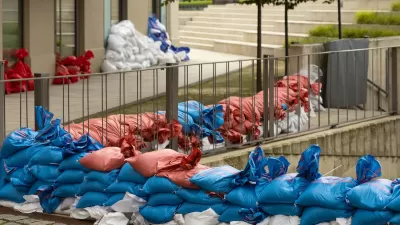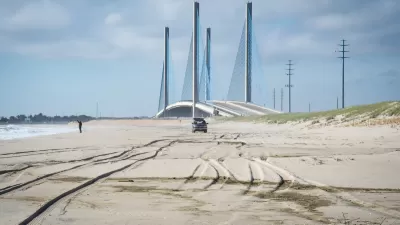Artificial reefs could offer a ‘softer’ flood management and erosion solution that doesn’t disrupt the flow of sediment.

Two pilot projects in Illinois are testing the potential of artificial reefs to reduce flooding risks in the Great Lakes, reports Lily Carey for Inside Climate News. The concept seeks to offer an alternative to concrete breakwaters and other flood mitigation tools that can exacerbate flood risk by compounding the effects of erosion.
Scientists managing the pilot projects plan to study how the reefs impact local shorelines and whether they could be a scalable solution for large lakes. According to researcher Hillary Glandon, “This project was hoping to come up with some softer designs, not necessarily fully stopping that movement of sand and water, but also a more cost effective design.”
As Carey explains, “Lake Michigan is already home to a handful of artificial reefs, most of which are located farther from shore as a habitat for marine life. Some researchers in the U.S., though, say these could serve the dual purpose of boosting fish populations and preventing erosion, disrupting waves so that they’re less intense when they crash ashore.”
Because the shores of Lake Michigan are lined with hundreds of private lots, shoreline management has often been a complicated project. “That makes artificial reefs particularly alluring in the Great Lakes—they’re a way to block wave energy without making erosion worse for neighbors, and they’re far cheaper than traditional infrastructure.” However, a lack of familiarity with nature-based interventions and a historical reliance on seawalls and breakwaters keep many residents wary of artificial reefs.
FULL STORY: Artificial Reefs Can Mitigate Coastal Erosion in the Great Lakes. Will Cities Agree to Adopt Them?

Alabama: Trump Terminates Settlements for Black Communities Harmed By Raw Sewage
Trump deemed the landmark civil rights agreement “illegal DEI and environmental justice policy.”

Study: Maui’s Plan to Convert Vacation Rentals to Long-Term Housing Could Cause Nearly $1 Billion Economic Loss
The plan would reduce visitor accommodation by 25% resulting in 1,900 jobs lost.

Planetizen Federal Action Tracker
A weekly monitor of how Trump’s orders and actions are impacting planners and planning in America.

Waymo Gets Permission to Map SF’s Market Street
If allowed to operate on the traffic-restricted street, Waymo’s autonomous taxis would have a leg up over ride-hailing competitors — and counter the city’s efforts to grow bike and pedestrian on the thoroughfare.

Parklet Symposium Highlights the Success of Shared Spaces
Parklets got a boost during the Covid-19 pandemic, when the concept was translated to outdoor dining programs that offered restaurants a lifeline during the shutdown.

Federal Homelessness Agency Places Entire Staff on Leave
The U.S. Interagency Council on Homelessness is the only federal agency dedicated to preventing and ending homelessness.
Urban Design for Planners 1: Software Tools
This six-course series explores essential urban design concepts using open source software and equips planners with the tools they need to participate fully in the urban design process.
Planning for Universal Design
Learn the tools for implementing Universal Design in planning regulations.
Caltrans
Smith Gee Studio
Institute for Housing and Urban Development Studies (IHS)
City of Grandview
Harvard GSD Executive Education
Toledo-Lucas County Plan Commissions
Salt Lake City
NYU Wagner Graduate School of Public Service





























